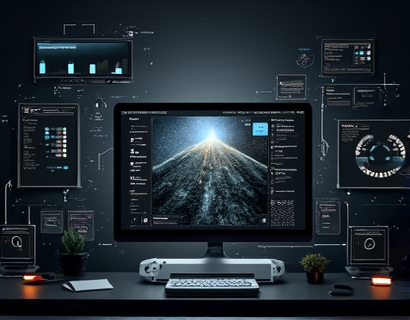AI Chat Interface: Transforming Competitive Gaming Community Engagement
The landscape of competitive gaming and esports is rapidly evolving, driven by technological advancements and the growing demand for immersive, interactive experiences. One of the most significant innovations in this space is the integration of AI-powered chat interfaces, designed to revolutionize how tournament enthusiasts, players, and fans engage with the gaming community. This article delves into the transformative impact of these AI chat interfaces, exploring how they enhance real-time updates, insights, and interactive discussions, ultimately enriching the overall community engagement and accessibility in competitive gaming.
Enhancing Real-Time Updates
One of the primary advantages of AI chat interfaces in competitive gaming is their ability to provide real-time updates. Traditional methods of sharing information, such as through static websites or scheduled social media posts, often fall short in delivering timely and relevant content. AI chat interfaces, on the other hand, can instantly push updates to users, ensuring they are always in the loop. This includes live scores, match results, and breaking news within the gaming community.
For instance, during a tournament, AI chat can broadcast the latest scores, player performances, and key moments as they happen. This immediacy not only keeps the audience engaged but also reduces the latency between events and the dissemination of information. For players and teams, real-time updates can be crucial for strategy adjustments and fan support, creating a more dynamic and responsive environment.
Providing In-Depth Insights
Beyond mere updates, AI chat interfaces offer in-depth insights that enrich the gaming experience. By leveraging advanced data analytics and machine learning algorithms, these platforms can analyze vast amounts of data from matches, providing detailed statistics, player performance metrics, and trend analyses. This level of insight is invaluable for both casual fans and serious enthusiasts.
For example, AI can break down a match into key plays, highlight strategic decisions, and offer expert commentary based on historical data. This not only enhances the viewing experience but also educates users about the intricacies of the game. For players, these insights can be used to refine their skills, learn from top performers, and gain a competitive edge.
Facilitating Interactive Discussions
Interactive discussions are a cornerstone of community engagement in competitive gaming. AI chat interfaces facilitate this by creating dynamic, real-time conversation spaces where users can share thoughts, opinions, and analyses. These platforms use natural language processing (NLP) to understand and respond to user inputs, making interactions more natural and engaging.
Users can join specific channels or topics related to tournaments, teams, or players, and engage in discussions that are moderated to ensure a positive and respectful environment. AI can also suggest relevant topics based on current events, ensuring the conversations remain timely and relevant. This level of interactivity fosters a sense of community and belonging among users, encouraging more frequent and meaningful participation.
Personalization and User Experience
AI chat interfaces excel in personalizing the user experience. By analyzing user behavior and preferences, these platforms can tailor content and interactions to individual users. For example, a user who frequently follows a particular team will receive more updates and insights related to that team, enhancing their overall experience. This personalization extends to notifications, ensuring users are alerted to content that matters most to them.
Moreover, AI can adapt the interface based on user interactions, making the platform more intuitive and user-friendly. This adaptability is crucial in maintaining user engagement, as it ensures the platform remains relevant and useful over time.
Accessibility and Inclusivity
Accessibility is a critical aspect of modern gaming communities, and AI chat interfaces play a significant role in making competitive gaming more inclusive. These platforms can offer multilingual support, making content accessible to a global audience. For users with disabilities, AI can provide text-to-speech, speech-to-text, and other assistive features, ensuring everyone can participate fully in the community.
Additionally, AI can help reduce barriers to entry by simplifying complex gaming jargon and providing explanations in simpler terms. This makes the platform more approachable for newcomers, encouraging a broader range of participants and fostering a more diverse community.
Enhancing Fan Engagement
Fan engagement is a key driver of success in competitive gaming, and AI chat interfaces are instrumental in boosting this engagement. By providing interactive features such as polls, quizzes, and live Q&A sessions, these platforms keep fans actively involved in the gaming experience. Fans can vote on game-related decisions, participate in live chats with players, and even influence certain aspects of the tournament through their interactions.
For instance, AI can facilitate fan-driven challenges where users can propose and vote on specific game modes or rules for upcoming matches. This not only increases fan participation but also adds an element of unpredictability and excitement to the tournaments. Such engagement strategies help build a loyal and active fan base, which is essential for the long-term success of any gaming community.
Data-Driven Decision Making
The insights generated by AI chat interfaces are not just for consumers; they are also valuable for organizers and stakeholders in the competitive gaming industry. By analyzing user interactions, preferences, and behaviors, organizers can make data-driven decisions to improve tournament design, marketing strategies, and community management.
For example, AI can identify the most popular times for user activity, helping organizers schedule tournaments during peak hours to maximize viewership and participation. It can also highlight the most engaging content types, guiding the creation of more compelling and relevant material. This data-driven approach ensures that resources are allocated efficiently, leading to better outcomes for all parties involved.
Building a Robust Community Ecosystem
The integration of AI chat interfaces into competitive gaming communities fosters a robust ecosystem where various elements work together harmoniously. This ecosystem includes players, teams, fans, organizers, and content creators, all connected through a shared platform. AI acts as the glue, facilitating seamless communication and interaction across this diverse group.
For players and teams, the platform serves as a central hub for communication, strategy discussions, and fan engagement. For fans, it provides a space to connect with like-minded individuals, share content, and participate in community activities. Organizers can use the platform to manage events, gather feedback, and enhance the overall tournament experience. Content creators can leverage the platform to produce and share high-quality, engaging content that resonates with the community.
Challenges and Considerations
While the benefits of AI chat interfaces in competitive gaming are substantial, there are also challenges and considerations to address. One key issue is ensuring the accuracy and reliability of AI-generated content. Misinformation or incorrect data can undermine user trust and the credibility of the platform. Therefore, rigorous testing and continuous improvement of AI algorithms are essential.
Another consideration is user privacy and data security. AI chat interfaces handle a significant amount of personal data, and it is crucial to implement robust security measures to protect user information. Transparency in data usage and compliance with relevant regulations are paramount to maintaining user trust.
Additionally, the digital divide remains a challenge, as not all users have equal access to the technology required to fully utilize AI chat interfaces. Efforts to make these platforms accessible on a variety of devices and networks can help bridge this gap and ensure a more inclusive community.
Future Prospects
The future of AI chat interfaces in competitive gaming looks promising, with ongoing advancements in AI technology poised to bring even more innovative features. One area of development is the integration of augmented reality (AR) and virtual reality (VR) to create immersive chat experiences. Users could interact with virtual representations of players, venues, and game elements, adding a new dimension to community engagement.
Another exciting prospect is the use of AI to predict tournament outcomes and provide strategic recommendations based on real-time data. This could transform how fans and players approach competitions, offering a more analytical and strategic layer to the gaming experience.
Furthermore, the expansion of AI chat interfaces to include more languages and cultural contexts will make these platforms even more global and inclusive. As the competitive gaming community continues to grow, the need for sophisticated, AI-driven tools to manage and enhance community engagement will only increase.
In conclusion, AI chat interfaces are revolutionizing the way competitive gaming communities interact and engage. By providing real-time updates, in-depth insights, and interactive discussions, these platforms enhance the overall experience for enthusiasts, players, and fans alike. As technology continues to evolve, the potential for AI to further transform the gaming landscape is vast, promising a more connected, engaging, and inclusive future for all.










































